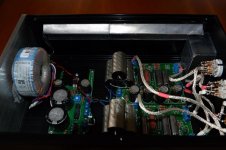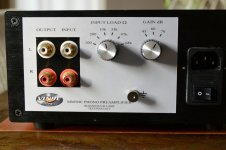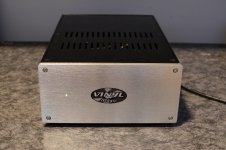Hi everyone!
This is my first post on this excellent site and, although I am a semi-retired loudspeaker designer, my first DIY attempt at building an amplifier of any kind.
My interest in analogue audio was re-kindled some time ago after clearing out the attic and discovering the carefully stored LP's from my younger years. Just for fun I started to play them again and haven't looked back since!
I made the decision to build myself a respectable analogue system and started by renovating a wonderful Lenco L78 SE deck. I soon found out that the onboard phono stage in my Rega pre-amp was the weakest link and decided to try and build a really good one. Having read all kind of reviews on the various audio forums I decided to go with the Boozhoud deluxe kit + PS. After the first shipment went missing somewhere in Saudi Arabia or the Australian Outback, Jason Cox of Boozhound quickly sent a replacement. Well done Jason!
The high quality of all the parts and clarity of the instructions have been mentioned many times before, views that I endorse entirely.
This particular design allows for adjustable gain up to 70 dB by way of a voltage divider. I decided that 3 levels would be most useful, 45, 60 and 70 dB for mm, mc and low ouput mc cartridges and populated a 4-pole 3-way rotary switch with the necessary (matched) resistances. The same goes for the input load resistance. With a 2-pole 6-way rotary I have a choice of 6 values, 100, 200 (for mc), 10k (for Grado), 33k, 47k and 68k (for mm).
Both of these switches have been placed on the rear panel of the the rather nice aluminium enclosure I bought on eBay. This enclosure is large enough to comfortably house the amp boards and the PS + 50W toroidal transformer.
After completing the build I hooked the thing up for some initial listening sessions. After allowing about 10 hours burn-in time I have to confess that I was a little disappointed in what I was hearing. As a loudspeaker designer I have evaluated many types and brands of capacitor and came to the conclusion that the final 10 uF MKP coupling capacitor after the buffer stage was probably not letting the potential quality of the amplifier shine through. So I replaced these with sets of 3 Audyn KpSn tinfoil, 160V, paralleled to give 11,1 uF. The increase in sonic quality was enormous. Far greater detail resolution, air around voices and instruments, and very convincing sound stage. So far so VERY good!
There was one more significant problem in that, at the highest gain setting, an unacceptable level of mains hum was present. I tried reconfiguring the positions of the boards and transformer with some small improvement but finally banished the annoying hum by screening the mains input socket/switch and cable to the transformer with 1.5 mm lead sheeting (quite easily cut and folded to size and glued in place with polymer construction mastic).http://www.diyaudio.com/forums/attachment.php?attachmentid=598388&stc=1&d=1486739116
I have now been using this phono stage for 3 months on a daily basis. And in that time I haven't played one single CD!! Recommendation enough I think!
http://www.diyaudio.com/forums/atta...=598390&stc=1&d=1486739116&stc=1&d=1486739116
Postscript 1
I have further experimented with the choice of coupling capacitor and have found that adding a 3,9 or 4,7 uF Audyn KpSn, in parallel, across the supplied MKP also give a very large cost effective improvement. The additional capacitance, in my system at least, also gives a little more air and "body" to the lower frequencies.
Postscript 2
There is one final niggle that hopefully someone may be able to help me with. At the highest gain setting there is what I would describe as a mild motorboating noise present. Could this be coming from the PS? When the input cables from the turntable are disconnected this noise is not present. Any ideas would be welcome.
The rest of my system:
Lenco L78 SE, renovated with Cardas twisted litz arm wiring. Grado Reference Platinum, Statement Platinum (0.5 mV) and AT 440MLb cartridges. Homemade low capacitance interlinks with Puresonic RCA plugs throughout. Creato modified Rega Cursa preamp, Rega Maia power amp. Homemade LS cables with cryogenic treated Tritech conductors. Modified Impulse Black Magic speakers (my design, capacitor free cross-over) with cryogenic treated Tritech internal wiring.
This is my first post on this excellent site and, although I am a semi-retired loudspeaker designer, my first DIY attempt at building an amplifier of any kind.
My interest in analogue audio was re-kindled some time ago after clearing out the attic and discovering the carefully stored LP's from my younger years. Just for fun I started to play them again and haven't looked back since!
I made the decision to build myself a respectable analogue system and started by renovating a wonderful Lenco L78 SE deck. I soon found out that the onboard phono stage in my Rega pre-amp was the weakest link and decided to try and build a really good one. Having read all kind of reviews on the various audio forums I decided to go with the Boozhoud deluxe kit + PS. After the first shipment went missing somewhere in Saudi Arabia or the Australian Outback, Jason Cox of Boozhound quickly sent a replacement. Well done Jason!
The high quality of all the parts and clarity of the instructions have been mentioned many times before, views that I endorse entirely.
This particular design allows for adjustable gain up to 70 dB by way of a voltage divider. I decided that 3 levels would be most useful, 45, 60 and 70 dB for mm, mc and low ouput mc cartridges and populated a 4-pole 3-way rotary switch with the necessary (matched) resistances. The same goes for the input load resistance. With a 2-pole 6-way rotary I have a choice of 6 values, 100, 200 (for mc), 10k (for Grado), 33k, 47k and 68k (for mm).
Both of these switches have been placed on the rear panel of the the rather nice aluminium enclosure I bought on eBay. This enclosure is large enough to comfortably house the amp boards and the PS + 50W toroidal transformer.
After completing the build I hooked the thing up for some initial listening sessions. After allowing about 10 hours burn-in time I have to confess that I was a little disappointed in what I was hearing. As a loudspeaker designer I have evaluated many types and brands of capacitor and came to the conclusion that the final 10 uF MKP coupling capacitor after the buffer stage was probably not letting the potential quality of the amplifier shine through. So I replaced these with sets of 3 Audyn KpSn tinfoil, 160V, paralleled to give 11,1 uF. The increase in sonic quality was enormous. Far greater detail resolution, air around voices and instruments, and very convincing sound stage. So far so VERY good!
There was one more significant problem in that, at the highest gain setting, an unacceptable level of mains hum was present. I tried reconfiguring the positions of the boards and transformer with some small improvement but finally banished the annoying hum by screening the mains input socket/switch and cable to the transformer with 1.5 mm lead sheeting (quite easily cut and folded to size and glued in place with polymer construction mastic).http://www.diyaudio.com/forums/attachment.php?attachmentid=598388&stc=1&d=1486739116
I have now been using this phono stage for 3 months on a daily basis. And in that time I haven't played one single CD!! Recommendation enough I think!
http://www.diyaudio.com/forums/atta...=598390&stc=1&d=1486739116&stc=1&d=1486739116
Postscript 1
I have further experimented with the choice of coupling capacitor and have found that adding a 3,9 or 4,7 uF Audyn KpSn, in parallel, across the supplied MKP also give a very large cost effective improvement. The additional capacitance, in my system at least, also gives a little more air and "body" to the lower frequencies.
Postscript 2
There is one final niggle that hopefully someone may be able to help me with. At the highest gain setting there is what I would describe as a mild motorboating noise present. Could this be coming from the PS? When the input cables from the turntable are disconnected this noise is not present. Any ideas would be welcome.
The rest of my system:
Lenco L78 SE, renovated with Cardas twisted litz arm wiring. Grado Reference Platinum, Statement Platinum (0.5 mV) and AT 440MLb cartridges. Homemade low capacitance interlinks with Puresonic RCA plugs throughout. Creato modified Rega Cursa preamp, Rega Maia power amp. Homemade LS cables with cryogenic treated Tritech conductors. Modified Impulse Black Magic speakers (my design, capacitor free cross-over) with cryogenic treated Tritech internal wiring.
Attachments
A slight bit of HF instability which would usually be cured by a very small value polystyrene capacitor ( 5pf/10pf) at the input ,"motorboating " was a well known tube radio fault dating from the 1930,s .
A power supply fault would normally introduce noise/hum etc .
If you have an oscilloscope connect it to the output first then trace back.
A link to his website states "he is on summer vacation " (boozehoundlabs.com)
OTOH---- yes it can be caused by faulty power supply rejection /phase shifts in the audio circuit.
If there is more than one stage in the amplifier then make small changes to the R/C coupling .
Make sure the power supply is a very low impedance .
Thats just some things to check.
A power supply fault would normally introduce noise/hum etc .
If you have an oscilloscope connect it to the output first then trace back.
A link to his website states "he is on summer vacation " (boozehoundlabs.com)
OTOH---- yes it can be caused by faulty power supply rejection /phase shifts in the audio circuit.
If there is more than one stage in the amplifier then make small changes to the R/C coupling .
Make sure the power supply is a very low impedance .
Thats just some things to check.


